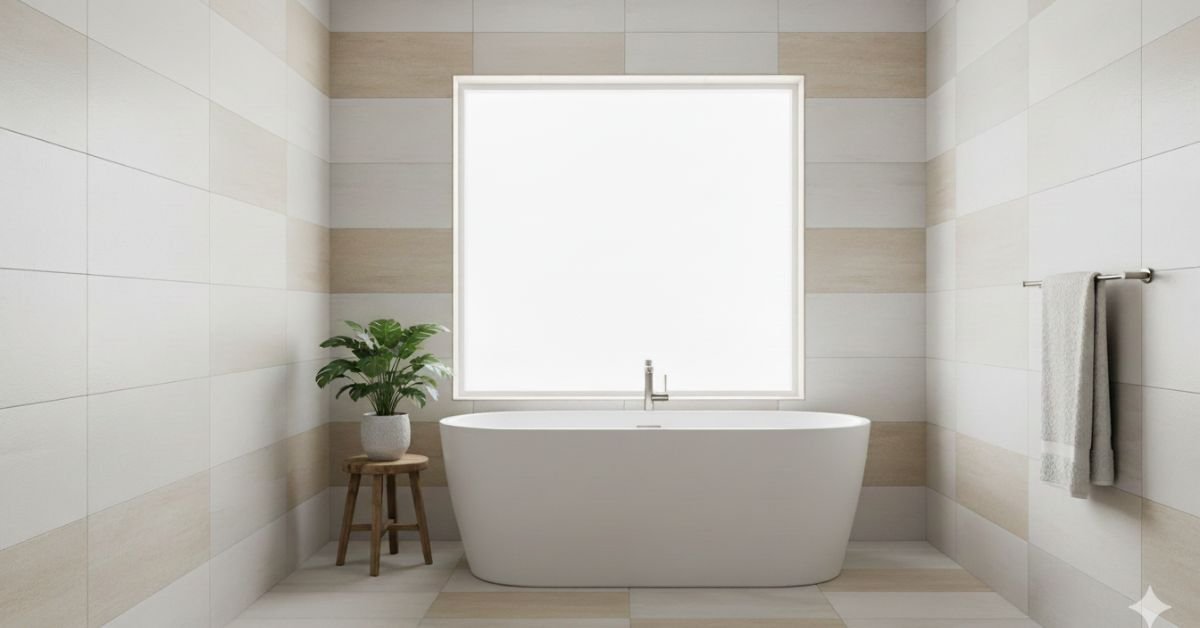Porcelain bathroom tiles have become a go-to choice for homeowners who want both style and practicality. Their dense surface helps resist moisture, making them ideal for areas that stay damp or get splashed often. For a complete overview of porcelain tiles used throughout the home, you can also read our Porcelain Tiles: Complete Guide for Homeowners. The finish stays smooth and clean, even in busy family bathrooms.
They also offer a strong visual range. Homeowners can find them in stone, marble, or concrete looks that bring character without the maintenance hassle. The colour stays consistent over time, and the tiles don’t fade even with frequent cleaning.
Durability may not be the first thing people think about when choosing bathroom décor, but porcelain tiles quietly deliver it. They last for decades with proper installation and care.
How Porcelain Bathroom Tiles Are Made
Porcelain bathroom tiles are made through a precise process that blends natural materials and high heat to create strength and beauty. The base starts with a mix of refined clay, feldspar, sand, and minerals like kaolin and silica. This combination is ground into fine powder and mixed with water to form a smooth clay mixture, ready for shaping.
The mixture is then dried and pressed into tile moulds using heavy hydraulic pressure. This step removes air and ensures density. Some tiles receive decorative prints or a protective glaze before being fired in kilns at around 1200°C. This high-temperature stage, known as vitrification, fuses the materials and locks out moisture.
After firing, some porcelain bathroom tiles go through rectification to refine edges for a seamless fit. Each tile is then inspected carefully for consistency before packaging.
Types of Porcelain Bathroom Tiles

Porcelain bathroom tiles come in several types, each offering different looks and performance features. Below is a breakdown of the main varieties:
-
Glazed Porcelain Tiles – These tiles have a protective coating that adds colour, pattern, and shine. Glazed finishes can be glossy or matt, making them ideal for both walls and floors.
-
Unglazed Porcelain Tiles – These have a natural surface with earthy tones and more grip, perfect for bathroom floors where slip resistance matters.
-
Matte Porcelain Tiles – With a smooth, light-diffusing surface, these tiles create a soft, modern finish and are easy to maintain.
-
Full-Body Porcelain Tiles – The colour and design run through the entire tile, making them highly resistant to scratches and wear.
-
Double-Charged Porcelain Tiles – Made by pressing two layers of porcelain together, these are dense and long-lasting.
Porcelain bathroom tiles also vary by style. Wood-effect tiles mimic timber flooring without water damage, stone-effect tiles recreate marble or concrete finishes, and mosaic tiles add texture and character to shower walls or borders. Each type suits different design needs while maintaining durability and moisture resistance.
What Type of Porcelain Tile Should You Choose for the Bathroom, and Why
Porcelain bathroom tiles should be chosen based on where they will be used — on the floor or the walls. For bathroom floors, textured or matte porcelain tiles are the best choice. These finishes provide grip and reduce slipping, which is essential in wet areas. Look for tiles with a PTV rating of 36 or higher to ensure slip resistance, especially in showers. Through-body porcelain tiles are also ideal as they are dense, durable, and perfect for busy households.
For bathroom walls, glazed porcelain tiles are preferred. The glazed surface offers a clean, polished look while resisting water and stains. These tiles also help maintain hygiene, as porcelain’s non-porous nature prevents bacteria and mould growth. Matte or textured tiles can also be used on walls to create a coordinated look with the floor.
Durability ratings matter too. A PEI rating of 2 suits walls, while PEI 3 or higher is better for floors. Porcelain bathroom tiles come in many shapes and designs, from square to hexagonal and even marble-look options, allowing homeowners to balance function with style.
Which Size of Tiles Is Best for Bathrooms
Porcelain bathroom tiles should match the bathroom’s size and purpose. Larger tiles create an open feel with fewer grout lines, while smaller ones offer more grip and flexibility in detailed spaces like shower floors. Choosing the right size helps balance style, safety, and cleaning ease.
-
Large tiles (60×60 cm or 60×120 cm): Best for floors and walls to make the bathroom look more spacious.
-
Medium tiles (30×30 cm): Good all-round choice for most bathroom areas.
-
Small or mosaic tiles (10×10 cm or smaller): Perfect for shower floors and accent borders.
What Are the Benefits of Porcelain Bathroom Tiles
Porcelain bathroom tiles offer a mix of strength, hygiene, and style, making them a long-term choice for both walls and floors. Their dense, non-porous structure prevents water absorption and mould growth, which helps maintain a clean, healthy environment. These tiles also resist scratches, stains, and temperature changes, ideal for areas that face daily wear.
-
Durability: Hard and dense surface resists chips and cracks.
-
Water Resistance: Non-porous design keeps moisture out.
-
Hygienic: Prevents bacteria and mildew build-up.
-
Low Maintenance: Needs only simple cleaning.
-
Stain Resistance: Spills can be wiped away easily.
-
Design Flexibility: A Wide range of colours and finishes available.
-
Eco-Friendly: Made from natural materials without harmful chemicals.
Porcelain bathroom tiles combine practicality with modern design, offering a surface that stays strong and attractive for years.
What Are the Disadvantages of Porcelain Bathroom Tiles
Porcelain bathroom tiles offer many benefits, but they also have some drawbacks that are worth noting. Their dense surface makes them durable but also cold and hard underfoot, which can feel uncomfortable without underfloor heating. The polished finish may become slippery when wet, posing a safety risk in bathrooms used by children or older adults. While porcelain is long-lasting, it can chip or crack if a heavy object falls on it.
-
Slippery Surface: Glossy tiles can be unsafe when wet.
-
Cold and Hard Feel: Can make standing for long periods uncomfortable.
-
Brittle Nature: Prone to chipping under heavy impact.
-
Difficult Installation: Requires expert fitting and special tools.
-
Higher Cost: More expensive than ceramic or vinyl options.
-
Grout Maintenance: Dirt can collect between tiles over time.
Porcelain bathroom tiles need careful handling and proper maintenance to balance their style with practicality.
How Is Porcelain Tile Different from Other Types of Bathroom Tiles
Porcelain tiles offer a denser, low-porosity choice that suits wet areas and heavy use. Below is a clear table comparing porcelain with other common bathroom tile types.
|
Feature |
Porcelain bathroom tiles |
Ceramic |
Natural stone |
Vinyl |
|
Composition |
Fine clays fired at high heat for a very dense body |
Softer clay fired at lower heat |
Cut from quarried stone such as marble or slate |
Synthetic sheet or planks made from PVC and fillers |
|
Water resistance |
Very low absorption, good for showers and floors |
Higher absorption unless glazed; better for walls |
Varies; many stones need sealing to resist water |
Waterproof options available |
|
Durability |
Hard surface resists scratches and wear |
Durable but less hard than porcelain |
Can scratch or chip; may stain if not sealed |
Wears faster in high traffic but softer underfoot |
|
Slip options |
Available in textured finishes for grip |
Textured or glazed options exist |
Natural texture may help grip |
Often textured for wet rooms |
|
Installation & cost |
Heavier and harder to cut; install costs rise |
Easier to cut; lower material cost |
Often costly and needs sealing; skilled fitters best |
Easiest and quickest to fit; usually cheapest |
This table helps pick the right material for function, safety, and budget.
How to Install Porcelain Tiles in Bathrooms (Step-by-Step Overview)

Installing porcelain bathroom tiles requires careful preparation and precision to ensure a long-lasting finish. Here’s a simple guide to follow:
-
Prepare the surface: Clean, level, and dry the area. Use a waterproof membrane or backer board, especially in wet zones.
-
Plan the layout: Dry-lay tiles to check placement, colour tone, and where cuts will go. This prevents uneven spacing near walls or fixtures.
-
Apply mortar: Mix thin-set mortar and spread it evenly with a notched trowel. For large tiles, apply mortar to the back of each tile too.
-
Set the tiles: Press each tile firmly into place, use spacers for even gaps, and check levels frequently.
-
Grout and seal: After curing, fill joints with grout, clean the surface, and apply a sealant to protect from moisture.
Follow the step-by-step guide of porcelain tiles to learn about installation details and maintenance.
Final Thoughts

Porcelain bathroom tiles combine strength, style, and practicality, making them a reliable choice for both modern and traditional spaces. Their water resistance, easy maintenance, and long lifespan make them ideal for floors, walls, and showers. With so many finishes and designs available, porcelain bathroom tiles allow homeowners to create a clean, durable, and timeless bathroom that balances function and beauty.
- If you’re planning to extend the same elegance and durability to your outdoor areas, check our Outdoor Porcelain Tiles: Types, Benefits and Disadvantages to learn how porcelain performs in exterior spaces.
Frequently Asked Questions
Q1. Are porcelain tiles good for bathroom floors and walls?
Yes. Porcelain tiles are dense, water-resistant, and durable, which makes them ideal for bathroom floors and walls. They handle moisture well and maintain their look for years with minimal maintenance.
Q2. How do I clean and maintain porcelain bathroom tiles?
Use mild soap or a pH-neutral cleaner with warm water. Avoid acidic products or harsh chemicals, and clean grout lines regularly to prevent staining.
Q3. How long do porcelain bathroom tiles last?
With proper installation and care, porcelain tiles can last over 20 years. Their strength and moisture resistance make them one of the most durable bathroom materials.
Q4. Can porcelain bathroom tiles crack easily?
Cracks are rare if installed correctly on a stable surface. However, dropping heavy objects or poor subfloor preparation can lead to damage.
Q5. What colour porcelain tiles make a bathroom look bigger?
Light shades like white, beige, and soft grey reflect more light and create a spacious look. Using larger tiles also helps reduce grout lines for a seamless finish.
Q6. Are porcelain bathroom tiles eco-friendly?
Porcelain tiles are made from natural materials like clay and feldspar. They last a long time and don’t emit toxins, which makes them an environmentally friendly option.
Q7. Why choose porcelain tiles for bathrooms?
Porcelain tiles are a smart choice for bathrooms because they’re waterproof, durable, and simple to clean. They resist stains, moisture, and wear while offering timeless style and long-lasting performance in wet areas.

